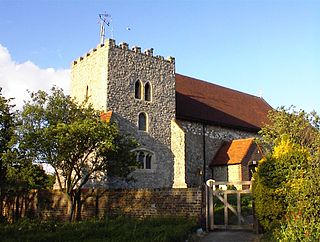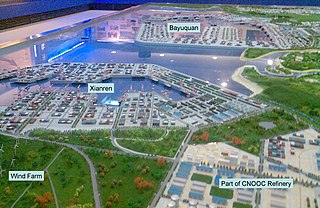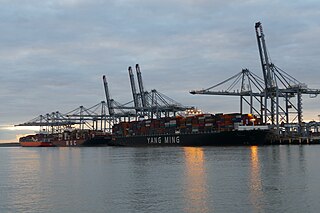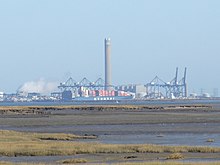The Port of London is that part of the River Thames in England lying between Teddington Lock and the defined boundary with the North Sea and including any associated docks. Once the largest port in the world, it was the United Kingdom's largest port as of 2020. Usage is largely governed by the Port of London Authority ("PLA"), a public trust established in 1908; while mainly responsible for coordination and enforcement of activities it also has some minor operations of its own.

Isle of Grain is a village and the easternmost point of the Hoo Peninsula within the district of Medway in Kent, south-east England. No longer an island and now forming part of the peninsula, the area is almost all marshland and is a major habitat for diverse wetland birds. The village constitutes a civil parish, which at the 2011 census had a population of 1,648, a net decrease of 83 people in 10 years.

The Port of Felixstowe, in Felixstowe, Suffolk, is the United Kingdom's largest container port, dealing with 48% of Britain's containerised trade. In 2017, it was ranked as 43rd busiest container port in the world and 8th in Europe, with a handled traffic of 3.85 million twenty-foot equivalent units (TEU). In 2019 it was ranked the UKs 7th busiest port.

The Hoo Peninsula is a peninsula in Kent, England, separating the estuaries of the rivers Thames and Medway. It is dominated by a line of chalk, clay and sand hills, surrounded by an extensive area of marshland composed of alluvial silt. The name Hoo is a Saxon word believed to mean 'spur of land' or refers to the 'distinct heel-shape of the ridge of hills' through Hoo. Hoo features in the Domesday Book. The peninsula is home to internationally and nationally protected wildlife sites as well as industrial facilities and energy industries.

Chennai Port, formerly known as Madras Port, is the second largest container port of India, behind Mumbai's Jawaharlal Nehru Port also known as Nhava Sheva. The port is the largest one in the Bay of Bengal. It is the third-oldest port among the 13 major ports of India with official port operations beginning in 1881, although maritime trade started much earlier in 1639 on the undeveloped shore. It is an artificial and all-weather port with wet docks. Once a major travel port, it became a major container port in the post-Independence era. An established port of trade of British India since the 1600s, the port remains a primary reason for the economic growth of Tamil Nadu, especially for the manufacturing boom in South India, and has contributed greatly to the development of the city of Chennai. It is due to the existence of the port that the city of Chennai eventually became known as the Gateway of South India.
Kamarajar Port, formerly Ennore Port, is located on the Coromandel Coast, Chennai about 18 km north of Chennai Port. It is the 12th major port of India, and the first port in India which is a public company. The Kamarajar Port Limited is the only corporatised major port and is registered as a company. Chennai Port Trust acquired around 67% stake of Centre in the Kamarajar Port Limited on 27 March 2020. The remaining 23 percent was already held by the Chennai Port Trust.

The Port of Halifax comprises various port facilities in Halifax Harbour in Halifax, Nova Scotia, Canada. It covers 10 km2 (3.9 sq mi) of land, and looks after 150 km2 (58 sq mi) of water.

The Port of Karachi is one of South Asia's largest and busiest deep-water seaports, handling about 60% of the nation's cargo located in Karachi, Pakistan. It is located on the Karachi Harbour, between Kiamari Azra Langri, Manora, and Kakapir, and close to Karachi's main business district and several industrial areas. The geographic position of the port places it in close proximity to major shipping routes such as the Strait of Hormuz. It is also ideally located to offer gateway services to the maritime trade for the Central Asian Republics (CARs). The administration of the port is carried out by the Karachi Port Trust, which was established in 1857.

Teesport is a large sea port located in the unitary authority of Redcar and Cleveland, in the ceremonial county of North Yorkshire, Northern England.

Coryton Refinery was an oil refinery in Essex, England, on the estuary of the River Thames 28 miles (45 km) from central London, between Shell Haven Creek and Hole Haven Creek, which separates Canvey Island from the mainland.
The Hundred of Hoo Railway is a railway line in Kent, England, following the North Kent Line from Gravesend before diverging at Hoo Junction near Shorne Marshes and continuing in an easterly direction across the Hoo Peninsula, passing near the villages of Cooling, High Halstow, Cliffe and Stoke before reaching the Isle of Grain and the container port on its eastern tip, Thamesport. There used to be a short branch line leading from Stoke Junction to the coastal town of Allhallows but this closed from 4 December 1961, the same date on which the Hundred of Hoo line was closed to passenger services.

Shell Haven was a port on the north bank of the Thames Estuary at the eastern end of Thurrock, Essex, England and then an oil refinery. The refinery closed in 1999 and the site was purchased by DP World who received planning consent in May 2007 for the new London Gateway deep water container port at the site. The neighbouring Coryton Refinery remained in operation until 2012.

The Port of Yingkou is an international seaport in Yingkou, Liaoning, People's Republic of China. It is the second-largest port in northeast China and the tenth-largest nationwide. It includes two separate dockland areas, the Yingkou old port at the mouth of the Daliao River, and the Bayuquan port located directly on Liaodong Bay on the Bohai Sea.

Grain Power Station is a 1,275 megawatts (1,710,000 hp) operational CCGT power station in Kent, England, owned by Uniper. It was also the name of an oil-fired, now demolished, 1,320MW power station in operation from 1979 to 2012.

DP World London Gateway is a port within the wider Port of London, on the north bank of the River Thames in Thurrock, Essex. Opened in November 2013, the site is a fully integrated logistics facility, consisting of a semi-automated deep-sea container terminal which is on the same site as a land bank for the development of warehousing, distribution facilities, and ancillary logistics services.

The BPRefinery (Kent) was an oil refinery on the Isle of Grain in Kent. It was commissioned in 1953 and had a maximum processing capacity of 11 million tonnes of crude oil per year. It was decommissioned in August 1982.

The Port of Saint John is a port complex that occupies 120 hectares of land along 3,900 m (12,800 ft) of waterfront of the Saint John Harbour at the mouth of the Saint John River in the city of Saint John, New Brunswick, Canada. The Port of Saint John, with facilities on both sides of the river, is noted for its extreme tidal range and river currents. Because of the semi-diurnal tides and the river influence, slack water occurs at approximately half tide and not at high or low water as at most other ports.
The Thames Hub is a proposal for a new approach to integrated infrastructure development that combines rail, intermodal freight logistics, aviation, tidal renewable energy and its transmission, flood protection and regional development in the Thames Estuary and connects this infrastructure to a trade and utilities spine that runs the length of the UK. It was developed by architects Foster + Partners, infrastructure consultants Halcrow and economists Volterra and launched by Lord Foster at the Institution of Civil Engineers in London on 2 November 2011.
Grain LNG Terminal is a Liquefied Natural Gas (LNG) terminal on the Isle of Grain, 37 miles (60 km) east of London. It has facilities for the offloading and reloading of LNG from ships at two jetties on the River Medway; for storing and blending LNG; for truck loading; and regasifying and blending natural gas to meet UK specifications. The terminal can handle up to 15 million tonnes per annum of LNG, has storage capacity for one million cubic metres of LNG, and is able to regasify up to 645 GWh per day for delivery into the high pressure gas National Transmission System (NTS). The facility is owned and operated by National Grid Grain LNG Ltd, a wholly owned subsidiary of National Grid.
Oil terminals are key facilities for the import, export, storage, blending, transfer and distribution of oil and petroleum products. Many terminals are located at coastal sites, such as Teesside and the lower Thames, to allow the offloading and loading of coastal shipping. Inland terminals, located around major cities, such as Birmingham and Manchester, facilitate the distribution of products to local industrial and commercial users. Many terminals have road tanker loading equipment for local distribution of products such as petrol, diesel, and heating oil. The terminals are connected through a network of underground pipelines to enable the transfer of oil and refined products across Britain.














